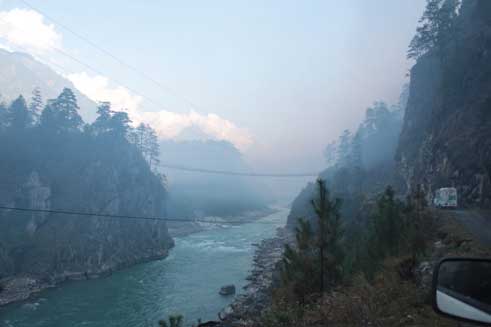[Denhang Bosai]
Situated 40 kms from Walong and nestled in a picturesque valley amidst pine-clad lofty mountains and enchanting ambience, is the first village of India, Kaho, from where China is only a stone’s throw away. It is 240 kms from Tezu in Lohit district. The sleepy and nondescript Kaho village is situated on the left bank of the mighty Lohit river, which flows in its crystal clear greenish colour in Kibithu circle of Anjaw district of Arunachal Pradesh. The literary meaning of Kaho is ‘dwelling place of many priests’. The total population of the village is only 78. The main occupation of the villagers is agriculture, horticulture and animal husbandry. They practise both jhum cultivation and WRC. The villagers are Buddhists. Chor, a variety of large cow, is their main domesticated animal that provides milk and is also used to plough their fields. The village boasts of a primary school and a health sub-centre. There is a heavy presence of security forces in the village’s periphery for obvious reasons and civilians are strictly prohibited from venturing beyond Kaho village.
The tribe residing in Kaho village is called Meyor, whose costumes and culture are akin to the Monpas, Membas and Tibetans. The Meyors are spread across Kibithu and Walong administrative circles. Villages like Kaho, Musai, Danbari, Chhota Khundun, Khawroti, Bara Khundun, Yaikung, Kunchhu, etc, fall under Kibithu circle. Interestingly, Meyors and Miju Mishmis live together in Yaikung and Kunchhu villages. The important Meyor villages in Walong circle are Wulong, Tinai, Dong, Saphung, Teryap, Namti, etc. The villages are small and their population is sparse. The Meyors celebrate a number of festivals and rituals every year. However, Lanchhut is their main festival and it is celebrated in the month of January. They also celebrate the New Year festival Losar in December and February. Almost all the Meyors can speak the Miju Mishmi dialect because of their proximity to their neighbouring tribe. The Meyors are mild and hospitable by nature and are patriotic to the core. History is evidence that they assisted the Indian Army during the Chinese aggression in 1962. In the past, the villagers of Kaho used to build their dwelling houses with pinewood. Even the roofing was of wood. But now, tin roofing has replaced the traditional practice.
There are Meyors in China also, bordering Kaho village. Some of the Meyor villages in China are Rungtut, Rungmat, Rungjit, Sangu, Samar Latam, Rimathong, etc. The Meyors of India and China residing in the borders used to practise border trades in the past that greatly benefitted the villagers in both the countries economically. However, this practice was stopped completely after the 1962 war. The life of the Meyors living in the borders is tough and unforgiving. With stiff mountains and harsh weather conditions, there is little or no scope for cultivation. The villagers are now starting to engage themselves in horticulture activities to augment their source of income. Kiwi grows very well there. The Kaho villagers have also started exploring the opportunities and possibilities of growth of the tourism sector and have built a few homestays to accommodate tourists. Thanks to the significance of Kaho as the first village of India and the breathtaking scenic beauty of the place, many tourists visit Kibithu and Walong circles every year. This will, without an iota of doubt, benefit the growth of the economy of the people in no small measure. There are inspection bungalows and homestays in Walong and Kibithu that the tourists can avail. The hot spring at Dong is worth visiting, and witnessing the first sunrise in Dong is very popular among the tourists.
Kaho village being strategically located and the Meyor tribe being one of the smallest in terms of population, government intervention is the sine qua non to facilitate Kaho village with more gainful government schemes and also to help and assist the Meyors to grow in all spheres of life. Tourism holds great promises for the people of Kaho and adjoining villages of Kibithu and Walong circles. Therefore, the government may initiate suitable steps to boost tourism there in order to engage the local people gainfully and also improve their fragile economy. While interacting with the DIPR team during the AKAM programme at Kaho village on 7 November, 2021, the spokesperson of the Meyor Welfare Society, TT Meyor and the GB of Khrowti and Bara Khundun, Unchan Meyor explained the hardships they face because of the remoteness of the village and passionately pleaded with the DIPR team to impress upon the state government to address the plethora of problems being faced by the people on priority. The two Meyor leaders lamented that there are only a few government teachers and clerks from the Meyor tribe with no single officer, mainly because of remoteness and lack of opportunities. With indescribable Mother Nature in her splendour best, Kaho beckons the tourists to feast on nature’s bountiful gifts and momentarily forget the trials and tribulations of life. (The writer is Deputy Director, DIPR.)



